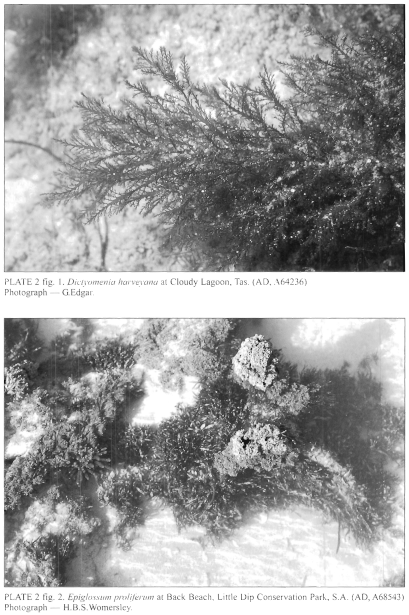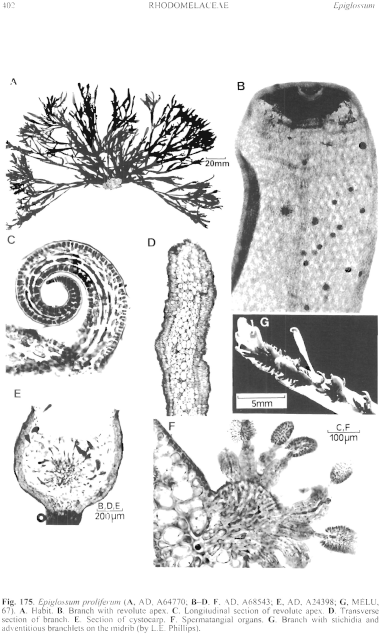|
|
|
|
|
|||||||||||
|
Electronic Flora of South Australia Species Fact Sheet
Phylum Rhodophyta – Family Rhodomelaceae – Tribe Amansieae
Synonyms
Amansia prolifera C. Agardh 1822: 194; 1824: 247.
Dictyomenia prolifera (C. Agardh) J. Agardh 1841: 27. Harvey 1847: 30. Kützing 1849: 848; 1864: 34, pl. 95c-f. Sonder 1855: 523.
Lenormandia prolifera (C. Agardh) J. Agardh 1863: 1103. De Toni 1903: 1119. Falkenberg 1901: 462. Guiler 1952: 106. Harvey 1863, synop.: xvi. King et al. 1971: 124. Lucas 1909: 46; 1929a: 23. Lucas & Perrin 1947: 302. May 1965: 397. Millar & Kraft 1993: 55. Saenger & Ducker 1971: 51, figs 1–12. Saenger et al. 1969: 59. Sonder 1880: 32. Tisdall 1898: 513. Wilson 1892: 166. Womersley 1966: 154.
Rytiphlaea simplicifolia Harvey 1859b: 298; 1863: pl. 246. J. Agardh 1863: 1095. Tisdall 1898: 513.
Thallus (Fig. 175A) dark brown, drying almost black, 5–15 (–25) cm high, cartilaginous, usually much branched for 3–4 orders from the midrib or proliferous from eroded apices, branches linear, flat, tapering basally and with rounded, recurved, apices, (2–) 3–5 mm broad and 240–300 µm thick, margins smooth, thickened, midrib inconspicuous, branch surfaces without proliferations. Holdfast discoid to crustose, 2–20 mm across; epilithic, just below low tide level or in deeper water. Structure. Apices rounded, recurved (Fig. 175B, C), apical cells within the recurved apices, conical, 15–20 µm in diameter, blade margins thickened. Apical cells cutting off probably 5 pericentral cells, with 2–4 pseudopericentral cells, forming an irregular medulla (Fig. 175D) 1–3 (–4) cells broad (the central cells largest) and a cortex 1–2 cells broad; secondary cortex formed over the midrib on older branches. Trichoblasts only associated with reproductive organs, reduced. Cells probably uninucleate; rhodoplasts discoid, chained in larger cells.
Reproduction: Reproductive organs borne on short, erect shoots over the midrib, rarely elsewhere. Gametophytes dioecious. Procarps formed in series on trichoblasts on polysiphonous branchlets on midribs. Carposporophytes with a basal fusion cell and much-branched gonimoblast with clavate terminal carposporangia 20–55 µm in diameter. Cystocarps (Fig. 175E) stalked, ovoid, 700–1000 µm in diameter; pericarp ostiolate, corticated, 4–5 cells thick. Spermatangial organs (Fig. 175F) on polysiphonous, simple or branched, erect shoots from a hemispherical base, ovoid, 70–110 µm in diameter, with a sterile basal cell and 3–5 fertile axial cells.
Stichidia (2–8) on proliferous shoots on the midrib (Fig. 175G), 0.5–1 (–4) mm long and 120–180 µm broad, compressed, corticated, sometimes with reduced trichoblasts, tetrasporangia in 2 rows, 50–80 µm in diameter.
Type from "N. Roll." (No. 24); holotype in LD, 42807; isotype in PC.
Selected specimens: Torpedo Rocks, Yallingup, W. Aust., drift (Royce 590, 31.v.1950; AD, A8000). Esperance, W. Aust., drift (Firman, Dec. 1951; AD, A18952). Troubridge Hill, S. Aust., 5 m deep (Edyvane, 30.x.1993; AD, A66356). Port Elliot, S. Aust., drift (Womersley, 24.vii.1949; AD, A11125). E end D'Estrees Bay, Kangaroo I., S. Aust., sublittoral fringe pools (Womersley, 11.i.1950; AD, A12687). Pennington Bay, Kangaroo I., S. Aust., uppermost sublittoral (Womersley, 30.i.1946; AD, A3005). Robe, S. Aust., drift (Womersley, 24.viii.1960; AD, A24398) and upper sublittoral pools (Womersley, 18.v.1964; AD, A28071-"Marine Algae of southern Australia" No. 134), and upper sublittoral pools (Womersley, 5.xii.1995; AD, A64770). Back Beach, Little Dip Conservation Park, S. Aust., reef pools (Womersley, 24.iv.2000; AD, A68543-"Marine Algae of southern Australia" No. 134a). Snapper Point, Beachport, S. Aust. (Phillips et al., 28.x.1998; MELU, 67). Point Bunbury, Apollo Bay, Vic., shaded pool (Womersley, 12.iv.1959; AD, A22642). Glaneuse Reef, Point Lonsdale, Vic., low eulittoral pools (Phillips, 4.xii.1998; MELU, 63). Walkerville, Vic., just below low tide (Sinkora A2145, 4.iii.1975; AD, A48567). Granville Harbour, W Tas., 3–10 m deep (Blackman, 28.i.1979; AD, A58506). Rocky Cape, N Tas., low eulittoral pools (Wollaston & Mitchell, 24.ii.1964; AD, A27650). Missionary Bay, Bruny I., Tas., 6–8 m deep (Womersley, 15.i.1949; AD, A10170). Dover, Tas., drift (Wollaston, 20.viii.1965; AD, A29555).
Distribution: Yallingup, W. Aust., to Walkerville, Vic., and around Tasmania; Twofold Bay, N.S.W. (Millar & Kraft 1993, p. 55).
Taxonomic notes: Epiglossum proliferum is a common species on rough-water platforms, often forming dense tufts just below low tide level; it also occurs to about 10 m deep.
References:
AGARDH, C.A. (1822). Species Algarum. Vol. 1, Pt 2, pp. 169–398. (Berling: Lund.)
AGARDH, C.A. (1824). Systema Algarum. (Berling: Lund.)
AGARDH, J.G. (1841). In historiam algarum symbolae. Linnaea 15, 1–50, 443–457.
AGARDH, J.G. (1863). Species Genera et Ordines Algarum. Vol. 2, Part 3, pp. 787–1291. (Gleerup: Lund.)
DE TONI, G.B. (1903). Sylloge Algarum omnium hucusque Cognitarum. Vol. 4. Florideae. Sect. 3. pp. 775–1521 + 1523–1525. (Padua.)
FALKENBERG, P. (1901). Die Rhodomelaceen des Golfes von Neapel und der angrenzenden Meeres-abschnitte. Fauna und Flora des Golfes von Neapel. Monogr. 26. (Friedländer: Berlin.)
GUILER, E.R. (1952). The marine algae of Tasmania. Checklist with localities. Pap. Proc. R. Soc. Tasmania 86, 71–106.
HARVEY, W.H. (1847). Nereis Australis, pp. 1–69, Plates 1–25. (Reeve: London.)
HARVEY, W.H. (1859b). Algae. In Hooker, J.D., The Botany of the Antarctic Voyage. III. Flora Tasmaniae. Vol. II, pp. 282–343, Plates 185–196. (Reeve: London.)
HARVEY, W.H. (1863). Phycologia Australica. Vol. 5, Plates 241–300, synop., pp. i-lxxiii. (Reeve: London.)
KÜTZING, F.T. (1849). Species Algarum. (Leipzig.)
KÜTZING, F.T. (1864). Tabulae Phycologicae. Vol. 14. (Nordhausen.)
KING, R.J., BLACK, J.H. & DUCKER, S. (1971). Port Phillip Bay Survey 2.8. Intertidal ecology of Port Phillip Bay with systematic lists of plants and animals. Mem. Natn. Mus., Vict. 32, 93–128.
LUCAS, A.H.S. & PERRIN, F. (1947). The Seaweeds of South Australia. Part 2. The Red Seaweeds. (Govt Printer: Adelaide.)
LUCAS, A.H.S. (1909). Revised list of the Fucoideae and Florideae of Australia. Proc. Linn. Soc. N.S.W. 34, 9–60.
LUCAS, A.H.S. (1929a). The marine algae of Tasmania. Pap. Proc. R. Soc. Tasm. 1928, 6–27.
MAY, V. (1965). A census and key to the species of Rhodophyceae (red algae) recorded from Australia. Contr. N.S. W. Natl Herb. 3, 349–429.
MILLAR, A.J.K. & KRAFT, G.T. (1993). Catalogue of marine and freshwater Red Algae (Rhodophyta) of New South Wales, including Lord Howe Island, South-western Pacific. Aust. Syst. Bot. 6, 1–90.
PHILLIPS, L.E. (2002b). Taxonomy of Adamsiella L.E. Phillips et W.A. Nelson, gen. nov. and Epiglossum Kützing (Rhodomelaceae, Ceramiales). J. Phycol. 38, 209–229.
SAENGER, P. & DUCKER, S.C. (1971). The morphology and development of Lenormandia prolifera (C. Ag.)J. Agardh (Amansieae, Rhodomelaceae). Aust. J. Bot. 19, 51–62.
SAENGER, P., ROWAN, K.S. & DUCKER, S.C. (1969). The water-soluble pigments of the red alga, Lenormandia prolifera. Phycologia 7, 59–64.
SONDER, O.W. (1855). Algae annis 1852 et 1853 collectae. Linnaea 26, 506–528.
SONDER, O.W. (1880). In Mueller, F., Fragmenta Phytographiae Australiae. Supplementum ad volumen undecinum: Algae Australianae hactenus cognitae, pp. 1–42, 105–107. (Melbourne.)
TISDALL, H.T. (1898). The algae of Victoria. Rep. 7th Meet. Aust. Ass. Adv. Sci., Sydney, 1898, pp. 493–516.
WILSON, J.B. (1892). Catalogue of algae collected at or near Port Phillip Heads and Western Port. Proc. R. Soc. Viet. 4, 157–190.
WOMERSLEY, H.B.S. (1966). Port Phillip survey, 1957–1963: Algae. Mem. natl. Mus., Vict. No. 27, 133–156.
The Marine Benthic Flora of Southern Australia Part IIID complete list of references.
Publication:
Womersley, H.B.S. (24 February, 2003)
The Marine Benthic Flora of Southern Australia
Rhodophyta. Part IIID. Ceramiales – Delesseriaceae, Sarcomeniaceae, Rhodomelaceae
Reproduced with permission from The Marine Benthic Flora of Southern Australia Part IIID 2003, by H.B.S. Womersley. Australian Biological Resources Study, Canberra. Copyright Commonwealth of Australia.
Illustrations in Womersley Part IIIA, 2003: PLATE 2 fig. 2; FIG. 175.

Plate 2 enlarge
PLATE 2 fig. 1. Dictyomenia harveyana at Cloudy Lagoon, Tas. (AD, A64236)Photograph - G. Edgar.
fig. 2. Epiglossum proliferum at Back Beach, Little Dip Conservation Park, S.A. (AD, A68543). Photograph - H.B.S. Womersley.

Figure 175 enlarge
Fig. 175. Epiglossum proliferum (A, AD, A64770; B–D, F, AD, A68543; E, AD, A24398; G, MELD, 67). A. Habit. B. Branch with revolute apex. C. Longitudinal section of revolute apex. D. Transverse section of branch. E. Section of cystocarp. F. Spermatangial organs. G. Branch with stichidia and adventitious branchlets on the midrib (by L.E. Phillips).

|
Email Contact: State Herbarium of South Australia |

|